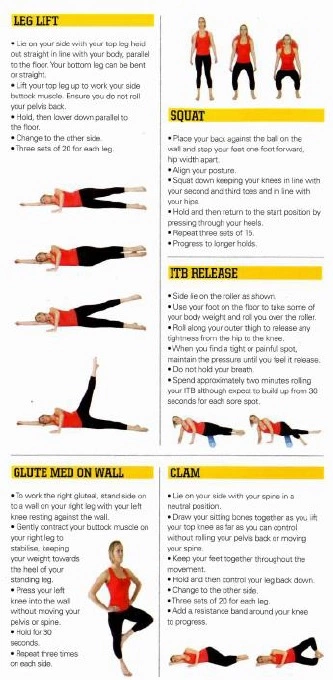There’s nothing more frustrating than a running injury knocking you off your training November 2015 Issue of TriathlonPlus
Runners hit the ground with anything between 5 and 9 times their body weight on each stride. Over distances from 5km to 26.2 mile marathon the cumulative effect of those impacts is immense, especially when taking into account the repetition during training and events.
For triathletes who regularly run and cycle, the main areas of weakness are the knees and ITBs (Iliotibial band) from the continual stress from flexion on the bike and extension movements required for efficient running.
Patello-femoral pain syndrome (PFPS) is also known as “Runner’s Knee” which occurs when the stress of running causes an irritation where the kneecap (patella) sits on the thigh bone (femur). The common causes of Runners Knee include overuse due to repeated bending and loading to the knee joint, direct trauma e.g. a fall, misalignment of the kneecap and a muscular imbalance of the thigh muscles which can lead to a disproportionate load on applied the knee cap, is often due to an ITB injury. An ITB injury could be caused by a mobility issue, strength, control or simple technique fault. It’s important to see a specialist to work out which of these factors are causing the band to rub over the knee so forcefully enough to cause pain in the first place.
Symptoms of runner’s knee may include Pain behind or around the kneecap, especially where the thighbone and the kneecap meet, pain when you bend the knee e.g. when walking, squatting, kneeling, running, or even rising from a chair. It may also be painful when walking downstairs or downhill, and it is common to experience a popping or grinding sensation behind the kneecap.
FIX IT
In the initial stages of pain it is important to rest the knee for a few days, with elevation, compression and regular application of ice if the knee is swollen. Taking anti-inflammatory medication may also be required if the pain and swelling is moderate to severe. Exercises
recommended for runner’s knee include the use of a foam roller to release the ITB, quads, hip flexors and gluteal muscles, hip flexor and gluteal stretches and strengthening exercises for the gluteal muscles in a non-weight bearing position initially, with progression into standing exercises. If pain persists with return to running after 5-10 days, it is recommended to consult your doctor, an Orthopaedic specialist or a Physiotherapist for further guidance or treatment.
It’s also important to remember that a staggering 50% of running injuries are reoccurrences and so prevention is key. Do not ignore sore spots – for example in the front or outside of your knee, front or inside of your shin, around your Achilles tendon – to prevent injury happening in in the first place. Although it can be frustrating, take the time to allow for the soft tissue healing process by resting and icing the area for a day or two. If this isn’t enough to ease pain continue to rest and try some light rehab for example cross training to maintain fitness, foam rolling areas above and below sore spot and taping if necessary. A running assessment may also be beneficial to identify any problems with running technique which may be affecting you biomechanics.

